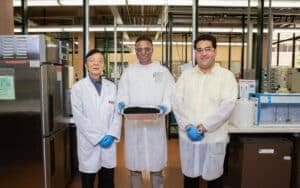[[{“value”:”
Freshly brewed coffee concrete may be coming to a street near you.
RMIT University in Melbourne has teamed up with Macedon Ranges Shire Council to conduct a world-first coffee concrete footpath trial.
Several other upcoming infrastructure projects around Victoria will also turn spent coffee grounds into biochar and transform the waste into a valuable resource for the construction industry.
The RMIT team will partner with Australian-owned BildGroup – a civil infrastructure, asphalt paving and road profiling company – to deliver these circular-economy projects.
“It’s very exciting to see this world-first trial of our coffee and wood-based biochar in these footpaths collaboration with Macedon Ranges Shire Council,” says Dr Rajeev Roychand of RMIT’s School of Engineering.
“Sand is getting scarce over time, and this waste can replace up to 15 per cent of the sand in concrete.”
Organic waste going to landfill, including spent coffee grounds, contributes 3 per cent of greenhouse gas emissions, but Rajeev and his colleagues at RMIT are set on transforming this waste into a valuable resource for the construction industry.
Organic waste cannot be added directly to concrete because it would decompose over time and weaken the building material. To overcome this challenge, the team has developed a technique to make concrete 30 per cent stronger by using coffee biochar made with a low-energy process without oxygen at 350°C to give the drink-additive a “double shot” at life and reduce waste going to landfill. They use a similar technique to turn other organic waste, including wood chips, into biochar that can also be used to make stronger concrete.
According to RMIT, Australia generates 75 million kilograms of ground coffee waste every year. Most of it goes to landfills, however, it could replace up to 655 million kilograms of sand in concrete because it is a denser material.
Globally, 10 billion kilograms of spent coffee is generated annually, which could replace up to 90 billion kilograms of sand in concrete.
Rajeev says coffee and wood-chip biochar can replace a portion of river sand that is used to make concrete. The team is collaborating with the council to trial both types of biochar in concrete footpaths in Gisborne.
A concrete sample undergoing a strength test in the researcher’s lab at RMIT University. Image: Carelle Mulawa-Richards, RMIT University.
Shane Walden, Council’s Director of Assets and Operations says it’s only a matter of time before people walk across the concrete that includes these products.
“Despite the fact that we’re using coffee grounds or mulch, residents aren’t going to really see or smell any difference in this concrete product,” he says.
“It’s really important for Council to be involved in projects such as this and to be working closely hand in hand with universities such as RMIT.
“This not only helps improve the knowledge level of our contractors and our staff, but it also has lots of other benefits and benefits that are important to our community. This includes helping the environment, acting sustainably and, most importantly, reducing waste to landfill and having a circular economy.”
The researchers will evaluate the performance of the concrete in these trial footpaths in Gisborne, with the aim of supporting the further roll out of this innovation.
“We are currently working in the supply chain sector so that we can make this research into a mainstream product for commercial applications, and we’re not only looking into coffee – we’re expanding this into all forms of different organic waste,” Rajeev says.
Professor Jie Li, Dr Rajeev Roychand and Dr Mohammad Saberian (left to right) with coffee biochar in their lab at RMIT University. Image: Carelle Mulawa-Richards, RMIT University.
“Every biochar produced from a different organic material comes with varying composition, in addition to the difference in carbon content, particle size and absorbency, that can boost the performance of concrete in a range of ways.”
There are potential cost savings for construction companies and concreters if this RMIT innovation can be integrated into the supply chain.
“Our research creates a potential to even reduce the required cement content. Since we are achieving a 30 per cent increase in strength for the coffee concrete, this could reduce the required cement content by as much as 10 per cent, based on our previous experience,” Rajeev says.
The trial with Macedon Ranges Shire Council did not reduce the amount of cement normally used to make concrete for footpath projects, but the RMIT team plans to experiment with using less cement.
“}]]


